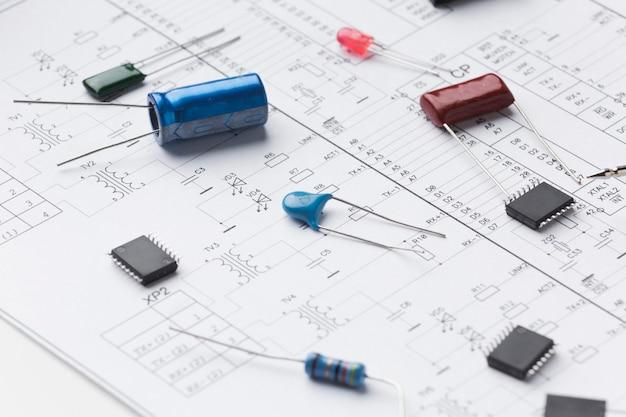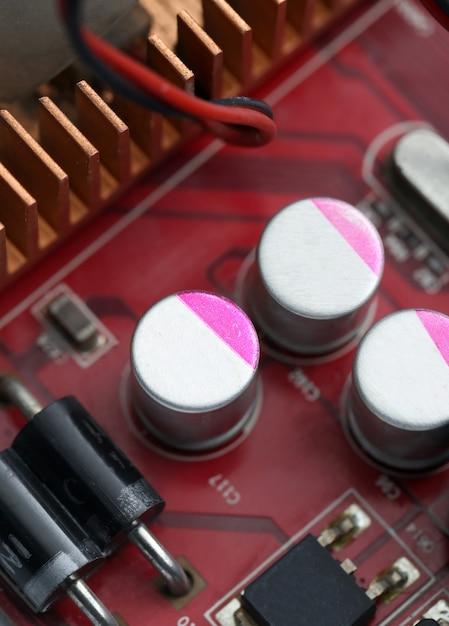The Role of Capacitors in Modern Electronic Devices
The Role of Capacitors in Modern Electronic Devices

Image source Freepik
Capacitors are passive electronic components whose primary functions are to store discharge electrical charge. Structurally, capacitors have two conductive plates on the opposite ends and a dielectric material in between the plates. This material, which in most cases is an insulator stores the electric charges. The two plates are positive and negatively charged and there is an electric field between the two plates. Also, between the two plates, there exists a potential difference. It ends up forming the voltage of the capacitor. During the charging process, electrical charges are fed into the capacitor. When discharged, this energy is drained from the capacitors.
Capacitors are widely used in small and large electronic devices. In this article, we are going to discuss the key roles of capacitors in modern electronic devices. We will cover what they do and how they execute each role in a device.
Key functions of capacitors
Here are some of the most important roles of capacitors in modern electronic devices:
Energy storage
This is the primary function of capacitors in electronic devices and applications. They are used for storing electrical energy that later on will be needed for performing different roles. During the charging process, a capacitor is supplied with electric charges that are stored in a dielectric material. To charge ca capacitor, you will have to connect one of the plates to a voltage source. A perfect example of energy storage by the capacitor is the flashlight that a camera emits. It depends on the energy that is stored in a capacitor.
Signal filtering
Capacitors are used for filtering signals, especially in AC electric circuits. A typical AC circuit comprises low and high waves. This is a representation of low and high voltage in a circuit. Capacitors are introduced into these circuits to filter out the unwanted AC elements so that you end up with a fairly stable output.
How does this happen? The whole filtering functionality of capacitors is based on their ability to store energy. They then discharge this energy into the circuit to balance the signal. The signal-filtering process takes place in two phases. Low-pass filter and high-pass filter. In a low-pass filter, the capacitor will allow the low-frequency signal to pass through the circuit while blocking the high-frequency signal. On the other hand, a high-pass filter allows high-frequency signals to pass through as low-frequency signals are attenuated.
In both filters, the output signal will be smooth and stable. Of course, other electronic components such as resistors are used with capacitors to achieve the desired level of signal filtering.
Power factor correction
This is another key role of capacitors in electronic devices. Power factor correction entails the process of compensating for the lagging current in an electric circuit. To achieve this a capacitor with a defined capacitance has to be connected to the power supply to form a leading current. This capacitor will force the power factor to be controlled and managed.
Poor management of power factors can easily lead to high energy loss and decreased energy efficiency. Capacitors correct the power factor by balancing the inductive reactive power in electric circuits. Introducing capacitors to these circuits helps to improve the overall energy efficiency of a device.
Coupling
This is another key role of capacitors in modern electronic devices. There are special coupling capacitors that are used for transmitting the alternating current signals from one node to another. As this happens, the capacitor will be blocking the DC signals from affecting the nodes. The main role of coupling capacitors is they preserve the values of current and voltage in electric circuits. This also helps to attain stable output signals.
Decoupling
This functionality is based on the capacitor to store energy. A decoupling capacitor will be just like any other energy storage device such as a battery. Normally, it takes some time for the capacitor to charge and discharge. Well, this time factor is what makes capacitors capable of executing their decoupling functions. This is because a capacitor will resist quick or drastic changes of power in circuits. For instance, if there is a drastic drop in the input voltage into a circuit, a capacitor will provide power that will be enough to keep the voltage stable.
Tuning
When tuning is mentioned, there is a high chance that you are thinking of radios and other frequency-dependent applications. To be precise, variable capacitors are used for setting resonance frequency in such applications. These capacitors are also used for impedance matching in antenna tuners. Of course, resistors are also for frequency tuning. By varying the capacitance of a device, you will also be changing its operating frequency. Tuning can be done mechanically or electronically depending on the nature of the variable capacitance that is used.
Voltage regulation
Capacitors can also play a protective role in electric circuits. They do this by regulating the voltage that is passing through a circuit. Here, the working mechanism entails releasing the stored energy when needed. By doing so, they ensure that the voltage remains constant or stable. This is a common functionality that is needed in devices that are prone to voltage spikes.
Used as voltage converters
Capacitors are also used as voltage converters in electronic devices. Two types of capacitors used for this function are the voltage inverter and voltage doubler. They are commonly used in a voltage multiplier circuit by connecting a capacitor to a diode. In most circuits, the output voltage is higher than the input voltage. Connecting several capacitors in series can help to achieve this goal. The output voltage will double or even triple the output voltage.
Timing circuits
Capacitors are used for making timing circuits in electronic devices. This works when capacitors charge and discharge at a rate that is determined by the size of the capacitor and the resistor. Timing circuits are commonly used in applications such as pulse generation and oscillators.
Starting and accelerating
Most mechanical devices such as electric motors require a high starting current. The direct current may not be sufficient enough to start the device. Electric energy from capacitors may come in handy in such applications. It boosts the input current so that there is sufficient torque to start up the device.
Restoring electric electrical energy
In some applications, capacitors are used for restoring electric energy in circuits. A perfect example is regenerative braking systems in electric and hybrid vehicles. The regenerative energy from the brake system is converted into electric energy that is stored in batteries and reused to propel the vehicle.
Choosing capacitors for electronic devices: What you should know

Image source Freepik
Now that you know all the key roles of capacitors in modern electronic devices, the next step is buying a capacitor that will do the job. Here are some of the factors that you should consider when choosing capacitors for your device:
· Consider the type of capacitor: There are different types of capacitors. They include ceramic capacitors, film capacitors, electrolytic capacitors, and paper capacitors. Each type of capacitor has unique features and is designed to function well in specific application areas. After doing a deep analysis, you should choose the suitable type for your device.
· Operating voltage: Choose a capacitor whose operating voltage matches the power requirements and specifications of your device. The voltage should be higher than the working voltage of the device and circuit. A high operating voltage is likely to translate to high capacitance.
· Capacitance: This is the measure of the number of charges that a capacitor can store. This will also depend on the application or device. It is always advisable to choose capacitors that have high capacitance.
· Tolerance: The tolerance of a capacitor represents the minimum and maximum range of a capacitor. The wider the tolerance the better.
· Operating temperature: Choose capacitors that have high operating temperatures. This means that they can withstand different temperature variations without getting damaged or underperforming.
· Dielectric type: You should pay attention to the type of material that makes up the dielectric of a capacitor. This will have an impact on the performance and other key properties of the capacitor.
I hope that these and many other tips will help you choose the right type of capacitor for your modern device.
Conclusion
At this point, you should appreciate the role of capacitors in modern electronic devices. They do more than just store electric charges. If you are building an electric device r system, chances are it will need capacitors to perform various roles that we have discussed in this guide. For this to happen, you will have to use the right capacitor. It should be of the right type and also have the technical specifications that meet the requirements of the application at hand.
Where can I get the best capacitors for my application? The surest place is from reliable electronic component distributors. They stock genuine and original capacitors for electronic devices. Rantle East Electronic is one such distributor. We are a reputable global electronic components distributor. With over 20 years of experience in the industry, we have the full capacity to deliver the right capacitors for your project. All that you need is to contact us and we will be glad to deliver.
Kevin Chen
Founder / Writer at Rantle East Electronic Trading Co.,Limited
I am Kevin Chen, I graduated from University of Electronic Science and Technology of China in 2000. I am an electrical and electronic engineer with 23 years of experience, in charge of writting content for ICRFQ. I am willing use my experiences to create reliable and necessary electronic information to help our readers. We welcome readers to engage with us on various topics related to electronics such as IC chips, Diode, Transistor, Module, Relay, opticalcoupler, Connectors etc. Please feel free to share your thoughts and questions on these subjects with us. We look forward to hearing from you!







 Start With
Start With Include With
Include With


